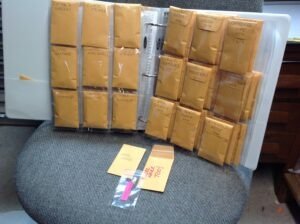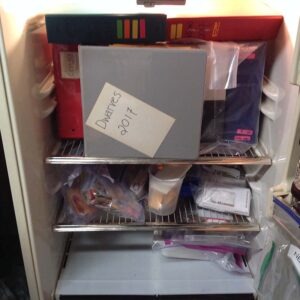Heirloom Tomato Seeds How To Store Them
Thanks for reading my blog, which I entitled “Heirloom Tomato Seeds How To Store Them”. I hope that you find something here that helps you.
After a long and successful season of growing your heirloom and open pollinated tomato plants, you have collected all of your seeds. Then you’ve started seeking effective ways to store them so they could have extended life. Here is my method that I have used through the years. I have been very successful doing things this way.
The paper Towel Method, Saving Seeds In Paper Towels
When I first started saving tomato seeds about 25 years ago, I simply squeezed them out on paper towels, waited until they were dried, then I stored them in any place where I could find them the following year. When it was time to start seeds once again, I simply ripped as many as I needed off of the towel and started them. This method always worked, and I usually had high germination. This success could have been so because they were stored in a place that wasn’t too hot. It could also have been so because they were just about 6 months old and not old seeds.
Seeds stored this way can be good for quite a few years(perhaps 3-5). I have seen seeds that were not well cared for, germinate even after 15 years. But I have also seen these same methods produce seeds that went bad after 2 years. Squeezing them right out of the tomato with their gels on them, onto a paper towel isn’t the most feasible and sure way to have high germination rates. It also does not help with the eradication of tomato diseases which may dwell on the seeds themselves. So even if you used the paper towel method to collect and save your seeds, additional steps should be taken to ensure seeds that will have a much longer futility and also are disease free, before you save them.
Here’s How I Store My Tomato Seeds With Excellent Results
Tomato seeds like to be stored in cool dark places. So refrigerating in a dark envelope to container would be excellent!
Once I have collected and processed my seeds, I DO 4 THINGS!
- I label a coin envelope with that varieties name.
- I label a 2×3 ziplock baggie. This baggie contains the seeds and goes inside the coin envelope.
- I label a binder with color of tomatoes and year harvested.
- I use baseball card holders inside the binder.
 Here is the process. Once things are labeled, I place some seeds into the ziplock bag. Remember, this bag is labeled too. I then place the ziploc bag with seeds, into the coin envelope. Coin envelope may or may not be sealed. So the ziplock keeps the seeds dry and the coin envelope helps to keep the seeds dark, as they love to be.
Here is the process. Once things are labeled, I place some seeds into the ziplock bag. Remember, this bag is labeled too. I then place the ziploc bag with seeds, into the coin envelope. Coin envelope may or may not be sealed. So the ziplock keeps the seeds dry and the coin envelope helps to keep the seeds dark, as they love to be.
The next thing I do is place the coin envelope in the a slot in the binder. I use the alphabetical system, so things would be easily retrieved when needed. As far as the binder, it too is labeled. I use the color and year system so I could find those category more easily. Just one small note, Using binders which are the same colors as the tomato varieties, helps greatly. Here is an example. Red varieties go in a red binder. Green varieties in a green binder. Yellow and white varieties in a yellow or white binder and black varieties in a black binder. You may mix this up in any way you want, but the objective is to more easily locate seeds when required.
Storing Tomato Seeds In the Refrigerator
 Experts have said that seeds stored in a refrigerator can have extended life. I have found this to be a very true statement, especially when stored in a dark container or paper bag. Many of my seeds that are fridge-stored, germinate at a high rate, even after 15 years. So after I have my seeds labeled and secured in a binder, I place that binder in the fridge until I need them once again. Under these conditions, they will just remain dormant until they are awaken by air warmth and moisture. Now that we have mentioned moisture, placing the binder in a plastic bag(large Ziploc, small trash) as extra protection is advised. This protects everything, in case there is a power outage or a broken refrigerator. Under these conditions the refrigerator will begin to condensate. When this happens, water falls everywhere. Though your seeds are protected in ziploc baggies, it may not be such a good thing to have water anywhere near them. Coin envelopes and labels on the zip lock baggies could be washed away, leaving you with nameless varieties. What a sad day that would be! And That’s All Folks!
Experts have said that seeds stored in a refrigerator can have extended life. I have found this to be a very true statement, especially when stored in a dark container or paper bag. Many of my seeds that are fridge-stored, germinate at a high rate, even after 15 years. So after I have my seeds labeled and secured in a binder, I place that binder in the fridge until I need them once again. Under these conditions, they will just remain dormant until they are awaken by air warmth and moisture. Now that we have mentioned moisture, placing the binder in a plastic bag(large Ziploc, small trash) as extra protection is advised. This protects everything, in case there is a power outage or a broken refrigerator. Under these conditions the refrigerator will begin to condensate. When this happens, water falls everywhere. Though your seeds are protected in ziploc baggies, it may not be such a good thing to have water anywhere near them. Coin envelopes and labels on the zip lock baggies could be washed away, leaving you with nameless varieties. What a sad day that would be! And That’s All Folks!
If you are interested in knowing how to collect and save heirloom and open pollinated tomato seeds, please see HERE.





